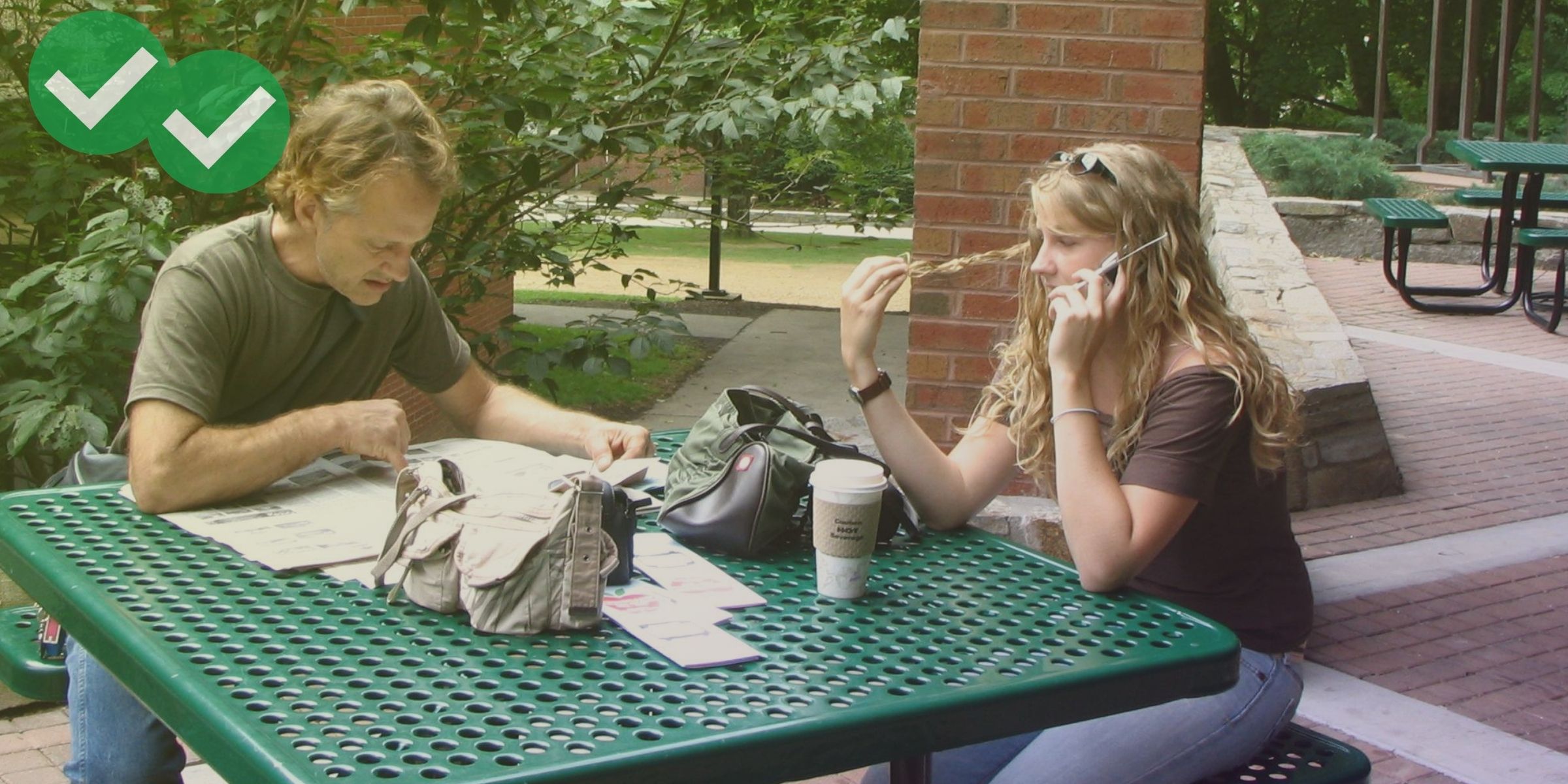
Unlike the TOEFL Independent Writing task, where you give your own opinion, TOEFL Integrated Writing topics require you to summarize opinions that you read and hear. This first task in TOEFL Writing really is all about note-taking, paraphrasing, and reporting. Read on to learn all about TOEFL Writing Task 1!
The TOEFL Integrated Writing Task requires you to read a passage that is about 250-300 words long. You then must listen to a lecture that is 2 to 2.5 minutes long. The lecture will challenge or disagree with the ideas in the reading passage for TOEFL Writing Task 1.
Because this task is so test-specific, it’s difficult to find authentic practice with TOEFL Integrated Writing topics, outside of official TOEFL prep materials that take questions from the real test. But you can find reading passages and audio for TOEFL Integrated Writing in the official TOEFL Writing practice sets. Additional free prep for this task can be found in TOEFL Quick Prep (the tasks all come with reading passages, but some of them have transcripts rather than audio).
You can also find practice for this TOEFL Writing task in the official TOEFL books from ETS. Last but not least, you can sharpen your TOEFL Writing skills by practicing a TOEFL Integrated Writing task from Magoosh, free of charge, right here in this post! Near the bottom of this page there is a TOEFL Writing Task 1 practice exercise with a sample answer.
Before we get to that mock test, though, let’s talk about a few basics of TOEFL Integrated Writing. Click the table of contents below to navigate these basics, and hop down to the practice exercise.
Table of Contents
- TOEFL Integrated Writing Topics: What to Expect
- Structuring Your TOEFL Integrated Writing Task
- Difficult Integrated Writing Tasks: What to Do
- Free TOEFL Integrated Writing Practice Task
- Model Answer for the Free TOEFL Integrated Writing Practice Task
- Additional Practice and Resources for TOEFL Writing Task 1
What should you expect from TOEFL Integrated Writing topics?
Since you’ll still be wearing headphones after the Speaking section, the Writing section begins with the integrated task, for which you’ll need to keep your headphones on.
So what do TOEFL Integrated Writing topics look like? Well, the materials you’ll be using to answer the question are a reading passage and a lecture excerpt. Both of these will be longer than the ones you encountered in the Integrated Speaking questions—the reading passage will give you three minutes to read, and it will go into more detail than the one in the Speaking section did.
Whereas other integrated reading samples have served mainly to define a key concept, the one in the Writing section will describe a process or defend a position. The lecture (actually, it will be a short part of a lecture) will then expand on this information by offering examples, explaining in greater detail, or, most likely, describing conflicting viewpoints on the topic introduced in the reading passage. The author will use reasons that respond directly to the ideas in the reading passage.
The question will follow one of several formulas. The question you answer will probably be almost identical to one of these:
- Summarize the points made in the lecture, being sure to explain how they cast doubt on specific points made in the reading passage.
- Summarize the points made in the lecture, being sure to explain how they challenge specific claims/arguments made in the reading passage.
- Summarize the points made in the lecture, being sure to specifically explain how they answer the problems raised in the reading passage.
- Summarize the points made in the lecture, being sure to specifically explain how they support the explanations in the reading passage.
- Summarize the points made in the lecture, being sure to specifically explain how they strengthen points made in the reading passage.
- Summarize the points made in the lecture, being sure to include specific reasons that they strengthen points made in the reading passage.
The first two are by far the most common; usually, you will hear a lecture that contrasts with the reading.
Altogether you will have 20 minutes to plan and write your TOEFL Integrated Writing essay. The essay will not be long—most responses are between 150 and 225 words—but there’s still no time to waste, and you’ll want to keep your writing skills sharp. Remember that your organization and content are just as important as your language use. Your essay needs to have a clear structure with separate points and specific examples that transition smoothly. Most of all, it’s very important to draw from both the reading passage and the listening passage. If you only reference the written passage, the very best score your essay can get is a 1. In many ways, the integrated essay is a summary of the lecture that you heard, but be sure to mention both sources.
You can take notes as you read and listen. With enough practice you will be able to identify the important points in the reading passage that will most likely be discussed in the lecture, and your notes should reflect that. Then, when you listen, it will be easy to take notes that relate to the ones that are already on your paper. Make as many connections between the two as possible while listening. If you have trouble with this, it’s okay—you can take a minute to connect information before you start writing, after the lecture is finished.
Typical TOEFL Writing Task 1 topics will be scholarly, the kinds of things that you’d read about or hear lectures about in an academic setting. Typical topics include things such as the spending habits of American consumers, lectures on history or classic literature, scientific debates, and so on. Topics will seldom be contemporary. For example, you are unlikely to see TOEFL Integrated Writing topics that focus on social media, cell phone use, contemporary popular culture, etc. These more modern topics are far more common in the TOEFL Independent Writing task that follows this one.
As you can see, success in TOEFL Integrated Writing is not just a matter of writing, but also comes down to reading and listening. For additional tips on these two skills in TOEFL Writing Task 1, read the following blog posts:
How should you structure your TOEFL Integrated Writing task?
Even though the 20 minutes you have to write the integrated essay will fly by, it’s still worth taking a minute or two to write an outline of your own prior to beginning your response (the test proctor will provide as much scratch paper as you need). Even jotting just a few lines that connect parts of your notes and circling the main examples you want to cover will give you the guidance you need to stay on task when writing your response.
Below I’ve written an outline that demonstrates an effective structure to use on the exam when responding to TOEFL Integrated Writing topics. I highly recommend that you practice writing with this outline as your guide, at least at first. Once you’ve gotten some feedback and have some good practice under your belt, you can deviate from it. At first, though, it’s good to know the rules before you break them, and to have a structure you can rely on when test day comes.
Note that this outline template involves a lot of paraphrasing. Before you get started on making a practice outline of your own, be sure to check out Magoosh’s tutorial on paraphrasing in TOEFL Integrated writing.
-
I. Introduction
A. General statement about the relationship between the resources you heard and read.
B. Short description of the structure of the lecture
II. Body
A. Paragraph on first point
1. Paraphrase the professor’s point
2. Contrast/compare with the reading
3. Give extra detail and additional specific examples on the professor’s point (optional)
B. Paragraph on second point
1. Paraphrase the professor’s point
2. Contrast/compare with the reading
3. Give extra detail and additional specific examples on the professor’s point (optional)
C. Paragraph on third point
1. Paraphrase the professor’s point
2. Contrast/compare with the reading
3. Give extra detail and additional specific examples on the professor’s point (optional)
III. Conclusion
A. Restate the relationship between the two sources (optional)
Note that you don’t have a conventional essay structure here. There is no thesis statement, and the difference between a body paragraph and introductory paragraph is less pronounced. When responding to TOEFL Integrated Writing topics, you also don’t have a concluding paragraph per se. If you’re having trouble picturing exactly what this looks like, you can see an example task and model answer at the bottom of this post. You can also see some sample essays for this task in the official TOEFL Writing practice set PDF from ETS. (And this PDF contains TOEFL Writing samples for task 1 as well!)
Above all, remember that the key to a good essay here is simply to take good notes on what you read and hear, and translate those notes into a full essay. For more info on the best ways to do that, see my post on note-taking and organizing your answer in TOEFL Integrated writing. Those tips can help you even when you encounter a particularly challenging Independent Writing task. And for more advice to help you through harder prompts, see the section immediately below.
Dealing with an Extra Hard TOEFL Writing Task
In all of the years that I’ve been tutoring the TOEFL, the part of the test that seems to inspire the most extreme reactions in students is the TOEFL Integrated Writing task. Students either happily breeze right through it or get very stressed out. Why? Because the difficulty levels on this task can vary so much! This, combined with the general complexity of the task, makes TOEFL Integrated Writing challenging for the average TOEFL test taker.
Ultimately, the TOEFL Integrated Writing task may be the hardest part of the TOEFL. This task requires not only keen English language skills, but also good analytical abilities. You need to bring together different, opposing ideas from the lecture and passage. This is a complicated job. And to make things even harder, the task comes almost at the very end of the test, when most test-takers are exhausted.
Some TOEFL Integrated Writing topics are harder than others. And if you get a hard Integrated Writing Task, you could be in danger of “blowing” your whole TOEFL IBT Writing section—doing badly on both tasks! An unusually difficult Integrated Writing task can leave you so tired and frustrated that you aren’t able to focus on the easier second TOEFL Writing Task.
So if you come across a harder-than-usual Integrated Writing Task on test day, make sure you handle it carefully. With the right strategies, a really tough TOEFL Writing Task 1 doesn’t need to hurt your TOEFL score at all.
Early detection of hard TOEFL Integrated Writing Topics
Click here to learn more
The worst thing you can do is not notice how hard an Integrated Writing Task is. If you mistakenly think an Integrated Writing task is relatively easy, you won’t plan for it correctly.
So try to immediately notice how complicated a task is. You should be able to tell just by looking at the reading passage, since the passage is the basis for the lecture. If the passage seems unusually complex, make note of this and proceed carefully. Don’t miss anything important, and don’t lose track of time. It’s really easy to leave out key facts or run down the clock in TOEFL Integrated Writing.
When you come across a potentially hard Integrated Writing Passage, start trying to mentally paraphrase the passage right away. Figure out whether you are able to paraphrase the passage effectively. Paraphrases should be shorter than their source, and should change the original wording significantly. If you are having a lot of trouble doing this, the passage may be too difficult for you to paraphrase.
Strategies once you’ve found a hard TOEFL Integrated Writing Task
Click here to learn more
If the ideas in the passage are really hard to paraphrase and shorten, don’t panic. For these more difficult Integrated Writing passages, there’s a simple solution: put less of the passage information into your essay. If necessary, put nothing directly from the passage into your essay.
This advice may sound strange. After all, the official TOEFL Writing Rubrics, which are used for scoring on the real test, say it’s important to include all the big ideas from the passage and the reading. But for a harder Integrated Writing Task, it really does pay to adjust your approach in this way.
Think about it. If the passage is really complex, then the lecture that follows will also be complex. And if the passage and the lecture are both very complicated, it can become almost impossible to correctly summarize them both. You won’t have enough time, and it’ll be too hard to focus on absolutely everything in the prompt. The lecture will need to be the main focus, since the task itself asks you to focus on the way that the lecture challenges the passage.
The lecture will of course contain ideas from the passage, since the lecturer is challenging the key points from the reading. So paying attention to what the lecturer says will allow you to indirectly use parts of the passage. And with this approach, you run less of a risk writing an unfocused or incomplete essay.
How this strategy can affect your score
Click here to learn more
Also remember how the TOEFL scoring system works. If you get a task that is harder-than-average, the TOEFL will adjust your task score upwards at least a little. Relying only on lecture content might hurt your score a bit. But you have a good chance of recovering those lost points when ETS adjusts your score. On the other hand, if you try to take on all of the complicated content in the task and fail, your score could really suffer, even with ETS’s score adjustments for difficulty. Ultimately, getting a high score on TOEFL Integrated Writing is a matter of balancing your priorities and focus, regardless of the difficulty level of a given individual task.
A Free TOEFL Integrated Writing Practice Task
I have written and recorded a task for you that closely follows the real TOEFL Integrated Writing Task in length, content, and format. Read the passage, listen to my lecture and follow the instructions for an (almost) authentic TOEFL writing practice experience. To prepare, you may want to read some of Magoosh’s advice on this task. The official TOEFL Integrated Writing Rubric (page 2 of the linked document) may also be useful. And at the bottom of this post, you’ll be able to view a sample response to this task.
TOEFL Integrated Writing Task Practice
Click here for the practice task
Directions: Give yourself 3 minutes to read the passage.
The “comics medium” includes newspaper comic strips such as Dennis the Menace and comic books such as Spider-Man. Scholars around the world agree that comics are a uniquely American art form.
The first commercially successful comic strip was Hogan’s Alley, a comic strip from the 1890s. Hogan’s Alley featured the Yellow Kid, the world’s first popular cartoon character. This strip and its character marked the beginning of comics and was American in every respect. Set in a low-income neighborhood in New York City, Hogan’s Alley dealt with the lives of ordinary Americans. It was written and drawn by American cartoonist R.F. Outcault. Joseph Pulitzer and William Randolph Hearst, two famous and influential American publishers, printed the comic strip in their newspapers.
The first popular comic book in the world was also American. Action Comics, a series that is still in print today, was initially released in 1938. It featured Superman, the world’s first superhero. Like Hogan’s Alley, Superman was American-created.
Americans invented comic strips, and Americans have exported their unique art form to the rest of the world. Japanese comics, called manga, were inspired by the comics that Americans brought to Japan after World War II. Popular European comics series such as Smurfs and Asterix are influenced by Disney comic books. Today, American-created Disney comic characters are more popular in Europe than ever.
The comics medium started in America. While it has spread around the world, even comics that aren’t created by Americans have an undeniable American influence. This is why so many art and literature scholars recognize the comic strip as a truly American art form.
Directions: Summarize the main points made in the lecture, being sure to explain how they challenge the specific points made in the reading passage. You have 20 minutes to plan and write your response. Your response will be judged on the basis of the quality of your writing and how well your response presents the points in the lecture and their relationship to the reading passage.
Listen to the lecture here:
Once you’ve completed the practice task, you can assess the quality of your answer by comparing it to this sample answer. Good luck!
Ready for a Full Writing Test?
If you’re ready to try the independent and integrated tasks together under test-like conditions, check out our full-length video Writing Test!
And if you want more writing practice, download the FREE TOEFL Practice Test PDF.
TOEFL Integrated Writing Task: Model Answer
I have written a level 5 answer, which you can read below. This answer is followed by some commentary on why this response would earn the full five points.
Click here for the answer and explanation
Model level 5 TOEFL Integrated Writing answer
In the passage, the author argues that comics are an art form that is very unique to the United States, but has been borrowed by other countries. The speaker corrects many things the author wrote about comics being an American art form. Although the writing says all scholars agree that comics are uniquely American, the lecturer says that in modern times, very few scholars agree with that.
The speaker then points out that, contrary to the writing, the first popular comic strips were not American. According to the speaker, 100 years before the first American comic strip, there were popular comic strips in Europe. The lecture also states that Hogan’s Alley, the 1890s comic strip described as American in the article, is not completely American because the comic characters were not Americans. Moreover, the publisher and creator of the comic were immigrants from other countries.
Additionally, the speaker disagrees with the article’s claim that American comic book Superman was the first popular comic book. Instead, the lecturer says the Belgian comic book Tintin was popular before Superman. Also, the author points out that Superman’s creator is Canadian, not American as the article says.
Finally, the speaker disagrees that American cartoon art influenced international comics, as claimed in the writing. He says that popular European comics have a uniquely European style. He also argues that Japanese comics are influenced more by traditional Asian art. Finally, the speaker notes that even American Disney comics characters are drawn by European artists.
Commentary
Per the official TOEFL Integrated Writing rubric, this answer would get a score of 5. It outlines all the main points from the lecture. It explains how each main point contradicts or challenges the main ideas from the reading. It is organized well, with good transition words for each paragraph. It has no major errors, using correct grammar and vocabulary. Look at this model answer and the rubric linked above as you write your own answer to the sample task. If you need some extra help, you can find a writing template for your own response here.
I also have some resources specific to this essay prompt. For a guide on how to paraphrase as you respond to this specific prompt, see my article “How to Paraphrase in TOEFL Integrated Writing.” And for advice on how to reise your TOEFL writing, using this model Integrated task as a specific example, see “How to Revise TOEFL Writing.” All of this advice is applicable to other TOEFL Integrated Writing essays as well! (And it can also be applied to Task 2!)
Follow-up TOEFL Integrated Writing Practice
For more TOEFL Integrated Writing tasks from Magoosh, check our the additional free TOEFL Integrated writing practice task found in Magoosh’s complete guide to TOEFL Writing samples. You may also want to consider signing up for Magoosh TOEFL (you can try a free trial of Magoosh TOEFL prep without entering any payment info, and then “go premium” if you like what you see).
You can also go to “the source”—official TOEFL Integrated Writing practice from ETS. This free TOEFL Integrated Writing task, which focuses on the ecological practices of American companies (a typical Integrated Writing topic) is a good place to start if you’re looking for some quick official practice that you don’t have to pay for. Unfortunately, this readily accessible official practice task is flawed: it has a transcript of a lecture, rather than lecture audio. The only free official TOEFL Integrated Writing task with an actual sound clip for the lecture is the one in the official online TOEFL mock test.
And the Magoosh Blog is a powerful resource for practice with both TOEFL Writing Task 1 and TOEFL Writing Task 2: our TOEFL Writing templates. You can also find resources for both TOEFL Writing Tasks in our TOEFL Writing Topics guide.








Leave a Reply